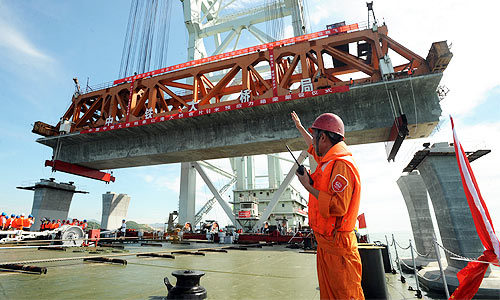|
 |
|
DEBT SCARE: The Xiangshan Port Bridge in Ningbo, Zhejiang Province is expected to complete construction by 2012 (GONG GUORONG) |
Cheng Siwei, a renowned economist and former Vice Chairman of the Standing Committee of the National People's Congress, said it is just a matter of time before China further tightens the monetary policy.
But that is less likely to happen in the near future as an early interest rate hike ahead of Western countries would accelerate hot money inflow and stir up waves in domestic financial waters, he said.
Zuo Xiaolei, chief economist at Beijing-based China Galaxy Securities Co. Ltd., said she believed there was no urgency to move on the interest rate. "The CPI was driven up by rising food prices and labor costs, and not excessive liquidity," she said. "Inflation pressure will recede in the rest of the year as the agriculture sector shakes off the impact of nationwide rainstorms."
China will need to walk a fine line between maintaining growth and managing inflation expectations, said the central bank report. Efforts to fend off financial risks and beef up the rebalancing toward healthier and more sustainable growth will also be enhanced.
Local debt concern
A grim spot on China's financial landscape is the financing vehicles of local governments used to provide money for roads, subways and other infrastructure projects. These vehicles take out bank loans backed by assets—typically land—or are supported by implicit guarantees of local governments.
Attempting to breathe fresh life into a sluggish economy, Chinese banks lent a record 9.6 trillion yuan ($1.4 trillion) of new loans last year, a chunk of which went into the local financing vehicles.
By the end of June 2010, commercial banks had extended an accumulated 7.66 trillion yuan ($1.14 billion) to these vehicles, said the China Banking Regulatory Commission (CBRC). Of this total, about 23 percent is faced with serious default risks due to a lack of qualified borrowers or guarantees.
Due to reckless expansion and less information transparency, the vehicles were adding to uncertainties hanging over the financial sector, said the central bank report.
If local government debt sours, banks will be saddled with a pile of bad loans, said Stephen Green, a senior economist at the Standard Chartered Bank in Shanghai.
Especially if the real estate market tumbles and land sales shrink, the local governments will take a heavy blow to their solvency, he said.
But Ba Shusong, a senior researcher at the Development Research Center of the State Council, downplayed the worries, and said the burden remained bearable. China's debt-to-GDP ratio was estimated at around 48 percent in 2009, well below the 229 percent of Japan and the 78.7 percent of the euro zone, he said.
In addition, even if local governments become insolvent, debt sustainability is not a problem, he said. Central budget can afford to support them, as fiscal revenue of the Central Government reached 3.59 trillion yuan ($528 billion) in 2009, 1.1 times of that of local governments.
Still, policy-makers have placed stringent controls over the financing vehicles. The State Council in May prohibited local governments from making illegal guarantees for them. In August, the Ministry of Finance, the National Development and Reform Commission, the central bank and the CBRC jointly released a circular, ordering a ban on bank lending to vehicles without a stable source of repayment funds.
Beside this, it was necessary to strengthen standardization and management of financing vehicles and reinforce supervision over commercial banks, said the central bank report.
It also suggested China should make efforts to meet demands of local governments for financing, such as allowing them to issue municipal bonds.
The local governments now have to hand over a majority of their revenues to the Central Government. These sorts of financial constraints are believed to be reasons why they have turned to different financing vehicles.
It would also help if China could securitize financing vehicles' loans and diversify the risks, said the report. | 